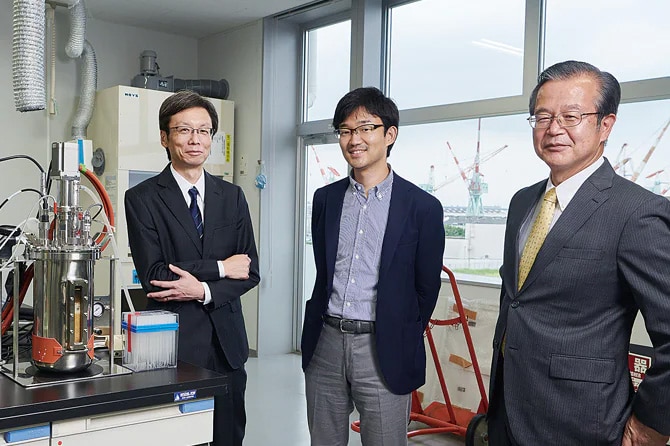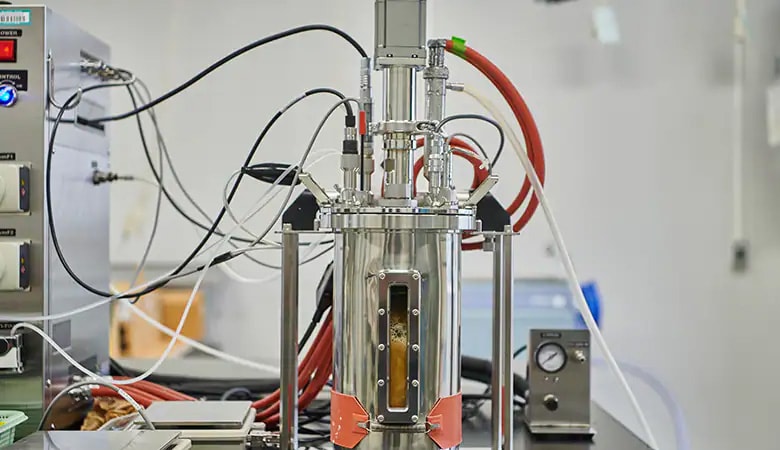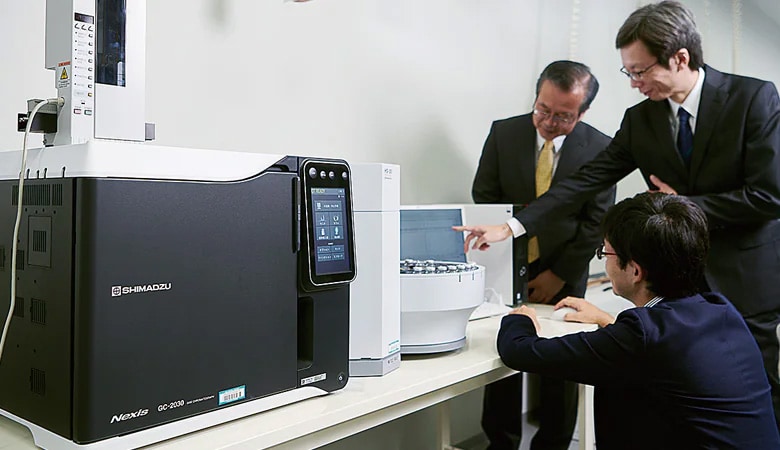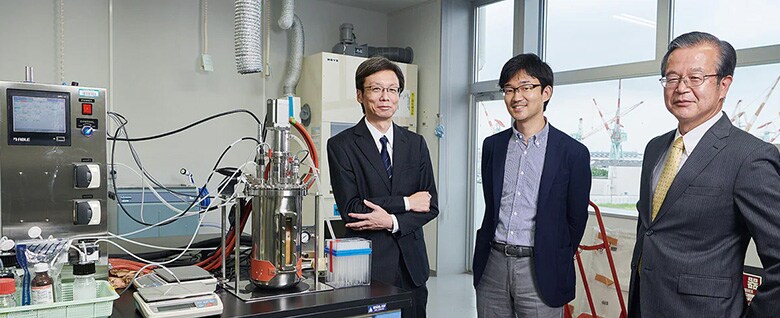Harnessing the Power of Microorganisms in Creating “Bio” Tires
Striving to Realize a Future Free from Dependence on Petroleum


Series: MOMENTUM
Harnessing the power of microorganisms instead of petroleum to create synthetic rubber. A collaboration that spans the line between industry and academia is helping to make a sustainable future a reality.
We want to leave our children with a future where they can enjoy peace of mind
“Rubber trees are truly amazing. They spend 50 or 60 years quietly storing carbon dioxide (CO2) and converting it into rubber. It’s like a model for an ideal biotechnology. Now, we have succeeded in accomplishing almost the same thing in the lab. It’s a truly moving achievement,” says Misao Hiza, an Advisory Fellow in the Research and Advanced Development Division of The Yokohama Rubber Co., Ltd.
Together with RIKEN and Zeon Corporation, Yokohama Rubber has developed technology that efficiently generates butadiene, the main ingredient in synthetic rubber, out of biomass. Although the term “decarbonization” was already a fixture in newspaper headlines before the announcement of the project’s success in April 2021, the news of the project attracted a particularly large amount of attention.
Typically, butadiene is industrially produced as a byproduct of the thermal cracking of naphtha. It is primarily used in tires, with more than 12 million tons used around the world each year.
“Petroleum has enabled us to live truly comfortable lives. However, if we keep going the way we’re headed, the Earth will be in a terrible state by the time it is inherited by future generations. That’s why we started thinking about using biomass material,” explains Hiza.
For Yokohama Rubber, one of the world’s largest tire manufacturers, it’s hard to imagine doing business without butadiene. However, this cannot be allowed to jeopardize the very future of our planet.
In 2012, Hiza was constantly gathering information on the topic. That’s when he met Tomokazu Shirai , a young bio-industry researcher at RIKEN who was a Senior scientist in the RIKEN Center for Sustainable Resource Science’s Cell Factory Research Team.
Shirai is an expert in designing “blueprints” of microorganisms that enable bio-production. The blueprints suggest regions of a genetic sequence that could be genetically modified to produce microorganisms capable of creating large amounts of target metabolites.
“In a sense, we were creating cells that just loved to make butadiene. Butadiene is an extremely important industrial intermediate. The aim of our work was to create cells that used processes such as fermentation to produce butadiene. It was an intriguing theme,” says Shirai.
Hiza also reached out to another Researcher - Yoshihide Yachi. Yachi was the General Manager of the Carbon Neutral Endeavor at Zeon, a synthetic rubber and specialty plastic manufacturer. Zeon had a long history as a technology partner of Yokohama Rubber, and in 1959, it became the first company in Japan to succeed in manufacturing synthetic rubber.
“It takes an enormous amount of time for petroleum to be created. However, the products made from that petroleum far exceed the Earth’s ability to ‘recover’ them: they don’t convert back into petroleum quickly. Biomass, on the other hand, breaks down immediately. The power of biomass is essential to creating a circular economy. I joined the team without even a moment’s hesitation,” reflects Yachi.
Designing microorganisms

A microorganism culture apparatus on a laboratory table in the Bio-monomer Production Lab. located on the RIKEN Yokohama Campus
In 2013, the three began their joint research. Their goal was to produce an enzyme reaction pathway for directly creating butadiene from glucose. There had already been several attempts to produce ethanol and other components from glucose, purify them, and convert them into butadiene. However, this process involves a circuitous path: fermentation, purification, and synthesis. If it were possible to design a direct reaction pathway, the energy consumption would be reduced, yielding an increase in productivity.
Shirai worked with experts in genome editing and enzyme design at RIKEN to design a microorganism, figuring out a number of pathways for converting glucose into butadiene.
He took genes from organisms such as soil bacteria and combined them with genes from E. coli to create a pathway for metabolizing a substance called muconic acid from glucose. Furthermore, he attempted to develop and combine new enzymes to produce butadiene from muconic acid, thereby creating a new synthetic pathway for butadiene production.
After years of trial and error, he found that butadiene was detected in a small fraction of the gas produced by E. coli that had incorporated an enzyme.

Device for analyzing the gas produced by microorganisms
Shown in the photo is the Shimadzu GC-2030 Gas Chromatograph
“It wasn’t much, but it was producing butadiene,” said Shirai. “That was an amazing discovery. We confirmed that the pathway itself wasn’t wrong, so we could increase production volume by fine-tuning it. We were able to discover this pathway thanks to the high sensitivity of the analytical instrument.”
Overcoming the “Valley of Death” between R&D and practical deployment

From left to right: Yoshihide Yachi, General Manager of the Carbon Neutral Endeavor, Zeon Corporation; Tomokazu Shirai, Senior scientist, Cell Factory Research Team, RIKEN Center for Sustainable Resource Science; and Misao Hiza, Advisory Fellow, Research and Advanced Development Division, The Yokohama Rubber Co., Ltd.
The team then ran repeated computer simulations to optimize the reactions and increase their production efficiencies. As a result, they succeeded in increasing butadiene production over 2,000-fold, compared to the original microorganism.
“I used to wonder how in the world of biotechnology, production could be increased by 10-fold, 100-fold, or even 1,000-fold depending on improvements. I could scarcely believe it, but it was true,” reflects Hiza.
“In ordinary chemical synthesis using catalysts, increasing production even two- or three-fold is difficult. But, sure enough, we did it. I was astonished to be honest.”
Of course, the butadiene produced was still no more than a low-molecular monomer. To turn it into rubber, it needed to be polymerized into a macromolecular compound (polymer). That’s where Zeon’s Yachi stepped up.
“Impurities are inherent in polymers, but biopolymers sometimes contain impurities that you don’t expect, so polymerization is a struggle. It is still at the laboratory level, but if it is produced at a plant, it could develop into a major problem. We need to investigate it closely and carefully.”
This year, the team finally succeeded in developing butadiene rubber using a new polymerization technology. It’s about the size of a palm, but it is rubber that was truly created using biotechnology.
“Now, I just want to make a tire out of this butadiene. At first, it will be very expensive, but as production scales up, the prices will come down. I have high expectations,” says Hiza.
During this period, the joint research of the three researchers was upgraded to RIKEN’s Integrated Collaborative Research Program with Industry, known as the “Baton Zone,” and closer collaboration was established for practical application.
“Research on biotechnology can be successful at the laboratory level, but it often suffers setbacks when it comes to commercial deployment. The main focus of the Baton Zone is to work more closely together to overcome these challenges. It is no doubt that we have come to this point because we have been able to understand each other’s positions in academia and industry,” says Shirai.
“Practical deployment might happen in the early 2030s,” ventures Yachi. “Of course, I want to bring it forward as soon as possible, even by one year. Now, it comes down to just how motivated the business end is. We’ve created an organization that promotes carbon neutrality efforts and we have a lot of enthusiasm about it.”
It was in the late 15th century when Columbus, landing on a Caribbean Island, was surprised to see locals playing with a bouncing ball made of natural rubber. 500 years later, humanity has now acquired a new type of “rubber tree.”
* This article is an English translation of our article originally published on the website “Boomerang”. The information, including affiliates and titles of the persons in this article, are current as of the time of interviewing.
 Copied
Copied

